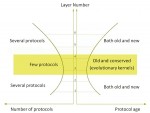Where IPs go to die: a theoretical look at the belly of the online beast

The key to a secure online world of tomorrow? Why, that would be an internet that spends a bit more time padding its waistline at the protocol buffet. Researchers at the Georgia Institute of Technology have developed an evolutionary model, dubbed EvoArch, that simulates a survival of the IP fittest battle for the interweb’s belly. Separated into six distinct layers, the top-to-bottom structure — specific applications, application protocols, transport protocols, network protocols, data-link protocols and physical layer protocols — reveals a fiercely competitive middle tier that often sees newer, non-specialized competition cannibalized in favor of an older, more dominant framework. The team created the theoretic model as a guideline for “architects of the future Internet… to increase the number of protocols in these middle layers,” thus protecting the web from potential security vulnerabilities. Despite these proposed layer variances, however, further simulations of the model only churned out more midriff slimming eventualities. It seems our dear internet is destined for a damned if you do, damned if you don’t hourglass-shaped evolution. Full PR after the break. Continue reading Where IPs go to die: a theoretical look at the belly of the online beast Where IPs go to die: a theoretical look at the belly of the online beast originally appeared on Engadget on Mon, 15 Aug 2011 17:20:00 EDT. Please see our terms for use of feeds . Permalink


Posted by
on August 15, 2011. Filed under
News,
Tech.
You can follow any responses to this entry through the
RSS 2.0.
You can skip to the end and leave a response. Pinging is currently not allowed.

